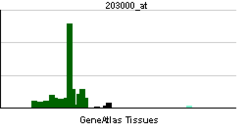STMN2
| View/Edit Human | View/Edit Mouse |
Stathmin-2 is a protein that in humans is encoded by the STMN2 gene.[3][4][5]
Function
Superior cervical ganglion-10 is a neuronal growth-associated protein which shares significant amino acid sequence similarity with the phosphoprotein stathmin (MIM 151442).[supplied by OMIM][5]
Interactions
STMN2 has been shown to interact with RGS6.[4]
References
- ↑ "Human PubMed Reference:".
- ↑ "Mouse PubMed Reference:".
- ↑ Okazaki T, Wang H, Masliah E, Cao M, Johnson SA, Sundsmo M, Saitoh T, Mori N (June 1996). "SCG10, a neuron-specific growth-associated protein in Alzheimer's disease". Neurobiology of Aging. 16 (6): 883–94. doi:10.1016/0197-4580(95)02001-2. PMID 8622778.
- 1 2 Liu Z, Chatterjee TK, Fisher RA (October 2002). "RGS6 interacts with SCG10 and promotes neuronal differentiation. Role of the G gamma subunit-like (GGL) domain of RGS6". The Journal of Biological Chemistry. 277 (40): 37832–9. doi:10.1074/jbc.M205908200. PMID 12140291.
- 1 2 "Entrez Gene: STMN2 stathmin-like 2".
Further reading
- Di Paolo G, Lutjens R, Pellier V, Stimpson SA, Beuchat MH, Catsicas S, Grenningloh G (February 1997). "Targeting of SCG10 to the area of the Golgi complex is mediated by its NH2-terminal region". The Journal of Biological Chemistry. 272 (8): 5175–82. doi:10.1074/jbc.272.8.5175. PMID 9030585.
- Antonsson B, Lütjens R, Di Paolo G, Kassel D, Allet B, Bernard A, Catsicas S, Grenningloh G (April 1997). "Purification, characterization, and in vitro phosphorylation of the neuron-specific membrane-associated protein SCG10". Protein Expression and Purification. 9 (3): 363–71. doi:10.1006/prep.1996.0710. PMID 9126608.
- Antonsson B, Kassel DB, Di Paolo G, Lutjens R, Riederer BM, Grenningloh G (April 1998). "Identification of in vitro phosphorylation sites in the growth cone protein SCG10. Effect Of phosphorylation site mutants on microtubule-destabilizing activity". The Journal of Biological Chemistry. 273 (14): 8439–46. doi:10.1074/jbc.273.14.8439. PMID 9525956.
- Lutjens R, Igarashi M, Pellier V, Blasey H, Di Paolo G, Ruchti E, Pfulg C, Staple JK, Catsicas S, Grenningloh G (July 2000). "Localization and targeting of SCG10 to the trans-Golgi apparatus and growth cone vesicles". The European Journal of Neuroscience. 12 (7): 2224–34. doi:10.1046/j.1460-9568.2000.00112.x. PMID 10947801.
- Neidhart S, Antonsson B, Gilliéron C, Vilbois F, Grenningloh G, Arkinstall S (November 2001). "c-Jun N-terminal kinase-3 (JNK3)/stress-activated protein kinase-beta (SAPKbeta) binds and phosphorylates the neuronal microtubule regulator SCG10". FEBS Letters. 508 (2): 259–64. doi:10.1016/S0014-5793(01)03090-3. PMID 11718727.
- Nixon AB, Grenningloh G, Casey PJ (May 2002). "The interaction of RGSZ1 with SCG10 attenuates the ability of SCG10 to promote microtubule disassembly". The Journal of Biological Chemistry. 277 (20): 18127–33. doi:10.1074/jbc.M201065200. PMID 11882662.
- Greka A, Navarro B, Oancea E, Duggan A, Clapham DE (August 2003). "TRPC5 is a regulator of hippocampal neurite length and growth cone morphology". Nature Neuroscience. 6 (8): 837–45. doi:10.1038/nn1092. PMID 12858178.
- Kuwabara T, Hsieh J, Nakashima K, Taira K, Gage FH (March 2004). "A small modulatory dsRNA specifies the fate of adult neural stem cells". Cell. 116 (6): 779–93. doi:10.1016/S0092-8674(04)00248-X. PMID 15035981.
- Gocke CB, Yu H, Kang J (February 2005). "Systematic identification and analysis of mammalian small ubiquitin-like modifier substrates". The Journal of Biological Chemistry. 280 (6): 5004–12. doi:10.1074/jbc.M411718200. PMID 15561718.
- Stelzl U, Worm U, Lalowski M, Haenig C, Brembeck FH, Goehler H, Stroedicke M, Zenkner M, Schoenherr A, Koeppen S, Timm J, Mintzlaff S, Abraham C, Bock N, Kietzmann S, Goedde A, Toksöz E, Droege A, Krobitsch S, Korn B, Birchmeier W, Lehrach H, Wanker EE (September 2005). "A human protein-protein interaction network: a resource for annotating the proteome". Cell. 122 (6): 957–68. doi:10.1016/j.cell.2005.08.029. PMID 16169070.
- Rual JF, Venkatesan K, Hao T, Hirozane-Kishikawa T, Dricot A, Li N, Berriz GF, Gibbons FD, Dreze M, Ayivi-Guedehoussou N, Klitgord N, Simon C, Boxem M, Milstein S, Rosenberg J, Goldberg DS, Zhang LV, Wong SL, Franklin G, Li S, Albala JS, Lim J, Fraughton C, Llamosas E, Cevik S, Bex C, Lamesch P, Sikorski RS, Vandenhaute J, Zoghbi HY, Smolyar A, Bosak S, Sequerra R, Doucette-Stamm L, Cusick ME, Hill DE, Roth FP, Vidal M (October 2005). "Towards a proteome-scale map of the human protein-protein interaction network". Nature. 437 (7062): 1173–8. doi:10.1038/nature04209. PMID 16189514.
- Lee HS, Lee DC, Park MH, Yang SJ, Lee JJ, Kim DM, Jang Y, Lee JH, Choi JY, Kang YK, Kim DI, Park KC, Kim SY, Yoo HS, Choi EJ, Yeom YI (July 2006). "STMN2 is a novel target of beta-catenin/TCF-mediated transcription in human hepatoma cells". Biochemical and Biophysical Research Communications. 345 (3): 1059–67. doi:10.1016/j.bbrc.2006.05.017. PMID 16712787.
- Manna T, Grenningloh G, Miller HP, Wilson L (March 2007). "Stathmin family protein SCG10 differentially regulates the plus and minus end dynamics of microtubules at steady state in vitro: implications for its role in neurite outgrowth". Biochemistry. 46 (11): 3543–52. doi:10.1021/bi061819d. PMID 17311410.
This article is issued from Wikipedia - version of the 6/5/2016. The text is available under the Creative Commons Attribution/Share Alike but additional terms may apply for the media files.

